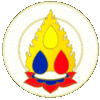Ashes

Vidyavajra lives in Cambridge, England
I’ve been working now for four months in the Cambridge City Crematorium as a Chapel Attendant. It is suprising how easily and quickly such an unusual work environment can become just what you do. Needless to say a crematorium for a Buddhist is never lacking in potential for reflection, just so long as you’re prepared to peak out occasionally from under the duvet. ‘ Ah ,yes, mortality, that inconvenient terminus where our body hits the buffers.’ The mortality of others is so easy to recognise, yet it is so easy to ignore in oneself. I walk a line hour by hour between insight and willful blindness and see how quickly the edge of receptivity can be dulled by repetition. ’Daily I see some of the consequences of death: bereavement and funerals. Occasionally I know a little bit of what lead up to it. I now know about cremations too and the end product of my work, an urn full of ashes.
A cremation oven is pretty damned warm, around a thousand degrees. At the Cambridge Crematorium we have four ovens. Each oven has a small peep hole for checking the progress of a cremation. I have to admit I find the cremation process fascinating. I frequently pull back the shield and peek while I’m on duty charging the coffins. I’ll spare you the details of what happens. It can all feel a tad ghoulish or inappropriate when put into words. As if it’s disassociated from feeling and all I’m watching is bread baking. Perhaps it helps not to have known any of these bodies when they were alive and kicking. We cremated Syd Barrett from Pink Floyd last week, but that doesn’t count. Fame is a poor relation. As Seneca put it ‘In the ashes we are all leveled’, even somnolescent rock stars. How would I feel if I knew the person being cremated? I’d feel very very attached.
A cremation takes about an hour and a half, longer if the person is fat. With increasing levels of obesity cremation times are rising. Once done I rake out what remains in the oven into an open topped steel box. In there are a collection of pure white bone fragments so fragile they crumble like a biscuit between your fingers. I remove all the large bits of metal , hip, knee or shoulder joints and the metal tubes used as drains for failing organs, that look like primitive nose flutes. What is left goes into the Cremulator which breaks the remaining fragments down into a fine granular ash. I don’t know how it does it, but all the ashes end up in a plastic container on one side, whilst all that’s left in the steel box are a few dozen coffin staples rattling around like spare change. It’s all slightly miraculous and uncanny.
Once I’ve emptied this ash into its urn or casket, then the label or name plate on the front is the only means of identifying it as a particular individual. Some commonly asked questions about ashes are - Do you get all the persons remains? (about 99%, but not everything). How will I know these are the right ashes? (you wont, but they will be). Actually there is precious little to define ashes as anyone specifically. Ashes weigh on average about 4lb. Generally, ashes of a male are heavy and large in quantity ,whilst ashes of a female are light and small in quantity. This is partly genetic, to do with height and build and partly to do with age as bone density weakens as you get older. But really talking of ashes as being literally male or female in any kind of meaningful way is quite ludicrous. We are all literally leveled to ash. In fact who is that we anyway?
A favorite paragraph of mine in Dogen’s Genjo Koan concerns ‘firewood and ashes’ and keeps coming to my mind during my current work. I’ll quote it in full, as editing it down to sound bites would be in danger of reducing a pause for reflection to merely what is instantly digestible.
"Firewood becomes ash; it can never go back to being firewood. Nevertheless, we should not take the view that ash is its future and firewood is its past. Remember, firewood abides in the place of firewood in the Dharma. It has a past and it has a future. Although it has a past and a future, the past and the future are cut off. Ash exists in the place of ash in the Dharma. It has a past and it has a future. The firewood, after becoming ash, does not again become firewood. Similarly, human beings, after death, do not live again. At the same time, it is an established custom in the Buddha-Dharma not to say that life turns into death. This is why we speak of no appearance. And it is the Buddha’s preaching established in the turning of the Dharma-wheel that death does not turn into life. This is why we speak of no disappearance. Life is an instantaneous situation, and death is also an instantaneous situation. It is the same, for example, with winter and spring. We do not think that winter becomes spring, and we do not say that spring becomes summer." [1]
I know that’s dense stuff, and in no way to be read over a bowl of Honey Nut Corn Flakes, without a cup of coffee handy. It’s something I’ve re-read and thought about, and know I still don’t fully grasp. At the same time I know it’s important and returns to my imagination repeatedly like a koan.
Another part of my job is ‘witness scattering’, where I scatter the ashes of a deceased person with members of the family present. Now a families approach to this varies widely. Some still believe in the ashes literally as their recently deceased. One lady rang up the Office distraught at the idea of scattering her husbands ashes on the lawns of the crematorium. The lawns obviously would need regular cutting and wouldn’t that mean his ashes would get hoovered up by the lawnmower and redistributed, nay mixed up with other peoples.
Other families are perhaps more associative and want the ashes scattered under trees, because ‘ she never liked strong sunlight’ or amongst beds of roses because’ he was a keen gardener’ or down in the woodland area because the deceased ‘liked being in touch with nature’
Some families struggle to see these ashes as anything to do with their dearly beloved. So they devise their own rituals or ways of making a connection. Like spelling out the persons name with the ashes, placing a picture on the spot or later planting a tree or a rose bush complete with a name plate. Anything that reminds them of a living thing or at least a living memory.
Cut off from the past and cut off from the future, the experience is of an absence in the present. All these approaches attempt to fill empty space. By use of family talismans and the spells and oracles of old memories, they invoke magically, for a brief moment, a shadow of the deceased in the present.
I find the scattering of ashes moving and feel privileged to take part in this parting ritual. In this ‘instantaneous situation’ of scattering the ashes, they look to all intents and purposes like concrete dust or cat litter. It seemed at first bizarre that people personified them so much. I’ve come to see that this is an understandable stage of bereavement, the ashes are a symbolic repository for emotions. They were an alive person, which became momentarily ‘firewood’ in the cremation oven and are now ash. On some unconscious level we do know that this ash is neither the person, nor the ‘firewood’ , that this amalgam of wood and bone dust, high in magnesium and potassium ,is not the person we loved.
So scattering ashes across a green sward is a final ritualised demonstration that the person we once knew is gone, they were never an unrecognizable square of gray dust. A subtle illusion falls away at this point. you can see it in even the most stoic or impassive of faces.
We all have questions about what happens after death, after the ashes. What next for the deceased? Dogen tells you what its not, hints at how it might be. It’s not ‘no appearance’ or ’no disappearance’, life doesn’t follow death, something does but its not the rebirth of a specific individual, there is and isn’t a connection between lives. There is only the ‘instantaneous situation’ that’s all he’s prepared to be remotely categorical about. He knows our tendency to be literal minded, how we concoct stories for the long running soap opera that is ourselves.
Our memories and imagination maintain connection with the deceased. Some search out spiritualist mediums and hope for messages from them. Something has permanently shifted in our cosmos. Things cannot return to how they were. Their absence can never be filled. We keep alive our memories, but they will fade and die with us. The ashes we know had a past, and ashes we know have a future, however unfathomable. Likewise what happens after our own death remains unfathomable, which maybe one reason for keeping our heads buried under the duvet.
--------------------------------------------------------------------------------
Note
1. From Shobogenzo Vol 1, translated by Nishijima & Cross, publisher Windbell. - return to text
Labels: Death, Vidyavajra

 rss
rss
0 Comments:
Post a Comment
<< Home